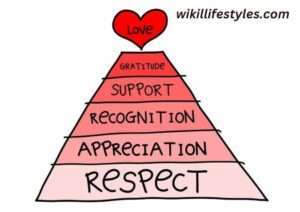Introduction : True Love vs Trauma Bond
Welcome to Wikilifestyles.com, where we unravel the intricate threads of relationships, emotions, and the delicate dance between love and its counterparts. In this comprehensive guide, we embark on a journey to understand and differentiate between two profound aspects of human connection – True Love and Trauma Bond.

Understanding Trauma Bond:
Before we delve into the heart of the matter, let’s illuminate the concept of a trauma bond. A trauma bond is a potent emotional connection formed between individuals who have experienced intense and often distressing situations together. It’s a complex intertwining of emotions that can be both compelling and challenging to break. In essence, it’s a deep connection born out of shared pain, creating a unique bond that may mimic the intensity of true love.

Defining True Love:
On the other end of the spectrum lies True Love, a force that transcends mere attraction. True Love begins with a blend of attraction and curiosity that evolves over time, encompassing the physical, sexual, emotional, and intellectual dimensions of a relationship. It’s characterized by stability, mutual respect, and a conscious choice to prioritize crucial conversations. True Love is an honor and a privilege, a connection that nurtures and flourishes with time.

True Love vs Trauma Bond – Unraveling the Intricacies:
Now, let’s turn our attention to the heart of the matter—the stark differences between True Love and Trauma Bond. As we explore these nuances, our aim is to provide you with insights that will empower you to distinguish between healthy connections and those born out of adversity.
In this guide, we will navigate through the meanings of trauma bond, delve into its significance, and unravel the characteristics that set it apart from the profound beauty of True Love. As we proceed, we will also touch upon related terms such as trauma bond meaning, what is a trauma bond, and the concept of love bombing.

Join us in this exploration as we shed light on the intricacies of human connection, offering guidance on recognizing the signs, understanding the dynamics, and ultimately fostering relationships that stand the test of time. True Love vs Trauma Bond—two powerful forces that shape our emotional landscapes—let’s navigate this journey together.
Navigating Love: Unveiling True Love and Trauma Bond
In the realm of human connections, True Love and Trauma Bond stand as powerful influencers, each with its distinct characteristics shaping the dynamics of relationships.
True Love: A Symphony of Connection
- Attraction and Curiosity: True Love begins with a delicate fusion of attraction and curiosity, a gradual evolution that unfolds over time, fostering a deep and meaningful connection.
- Holistic Bond: The bond in True Love extends beyond the physical and sexual realms, embracing the emotional and intellectual dimensions. It’s a comprehensive connection that nourishes all facets of a relationship.

True Love vs Trauma Bond - Stability and Mutual Respect: Stability becomes a hallmark of True Love, grounded in mutual respect. The relationship becomes a haven of security, allowing both partners to flourish individually and together.

True Love vs Trauma Bond - Crucial Conversations: Prioritizing crucial conversations is a cornerstone. Open communication becomes a key focus, enabling partners to navigate challenges, express needs, and foster understanding.

True Love vs Trauma Bond - Honored Choice: True Love is perceived as an honor, a privilege, and a conscious choice. The relationship is not merely a happenstance but a deliberate decision to embark on a journey together.
Trauma Bond: A Rollercoaster of Intensity
- Instant Attraction: Trauma Bond kicks off with instant attraction and irresistible chemistry, creating an intense connection right from the beginning.
- Predominantly Physical: The connection in Trauma Bond is predominantly physical and sexual, overshadowing other dimensions of a relationship.

True Love vs Trauma Bond - Cycles of Intensity: The relationship experiences intense highs and lows in recurring cycles, creating a rollercoaster effect that can be emotionally draining.

True Love vs Trauma Bond - Avoidance of Conversations: Avoidance becomes a defining feature, especially when it comes to important conversations. The reluctance to address issues hinders the growth of the relationship.

True Love vs Trauma Bond - Addiction Dynamics: The relationship feels akin to an addiction, where the sense of powerlessness to quit prevails. Breaking free from this bond becomes a formidable challenge.
Conclusion: True Love vs Trauma Bond
Breaking the Chains, Embracing True Love
In the intricate tapestry of human connections, the disparity between True Love and Trauma Bond is stark, affecting the very essence of our emotional landscapes. As we conclude this exploration, it is imperative to shed light on the disadvantages of being ensnared in a trauma bond and the liberating path toward breaking free.
Disadvantages of a Trauma Bond:
- Emotional Turmoil: Trauma bonds often subject individuals to a relentless cycle of emotional highs and lows, causing profound emotional turmoil.

True Love vs Trauma Bond - Stunted Growth: The intensity of a trauma bond can hinder personal growth, as individuals find themselves trapped in a cycle of dysfunction.
- Communication Barriers: Avoidance of crucial conversations becomes a detrimental aspect, hindering the development of a healthy and communicative relationship.

True Love vs Trauma Bond - Powerlessness: Perhaps most significantly, being in a trauma bond can lead to a sense of powerlessness, akin to an addiction, where breaking free feels insurmountable.

True Love vs Trauma Bond
Breaking the Trauma Bond:
- Self-Awareness: Recognizing the existence of a trauma bond is the first crucial step toward liberation. Self-awareness empowers individuals to confront the issues at hand.
- Seeking Support: Breaking free from a trauma bond often requires external support. Seeking the guidance of friends, family, or professional counselors can provide invaluable assistance.
- Establishing Boundaries: Setting clear boundaries is essential. This involves recognizing toxic patterns and actively working towards creating a space for personal growth and healing.

True Love vs Trauma Bond - Professional Help: In some cases, professional intervention may be necessary. Therapeutic support can provide individuals with the tools and strategies needed to overcome the challenges posed by a trauma bond.

True Love vs Trauma Bond
The Significance of True Love:
In stark contrast to the tumultuous nature of a trauma bond, True Love stands as a beacon of stability, respect, and genuine connection. Choosing the path of True Love involves honoring oneself and one’s partner, fostering open communication, and prioritizing growth together.

Closing with a Famous Quote:
To encapsulate the significance of True Love, let us borrow the words of the renowned American writer Richard Bach, who once said, “True love stories never have endings..” In True Love, the light of understanding, compassion, and growth enters through the vulnerabilities and challenges, illuminating the path toward a fulfilling and enduring connection.

As we part ways, may this exploration serve as a guide, empowering you to recognize the intricacies of your own relationships, make informed choices, and embark on a journey toward the profound and transformative power of True Love.
FAQ : True Love vs Trauma Bond
Q1: What are the signs of genuine love?
A1: Genuine love is evident through consistent support, mutual respect, and shared growth. Acts of kindness, open communication, and a commitment to each other’s well-being are clear indicators. It involves a deep emotional connection, trust, and a sense of security.
Q2: How can I identify toxic relationship indicators?
A2: Watch for patterns of control, manipulation, or emotional abuse. Consistent negativity, lack of communication, and feelings of diminishing self-worth are red flags. Trust your instincts and seek support if these signs arise.
Q3: Why is emotional connection crucial in love?
A3: Emotional connection forms the foundation of love, fostering intimacy, understanding, and a feeling of safety. Partners who openly share emotions and engage in active listening cultivate a profound connection, making love resilient in the face of challenges.
Q4: What are effective strategies for breaking free from trauma bonds?
A4: Breaking free from trauma bonds requires self-awareness, setting boundaries, seeking support, and possibly professional intervention. Identify and disrupt unhealthy patterns, commit to personal growth, and surround yourself with a supportive network.
Q5: How do I distinguish healthy love from a trauma bond?
A5: Healthy love promotes growth, mutual respect, and emotional safety. Evaluate stability, communication patterns, and overall impact on well-being. Seek professional guidance if uncertainty persists.
Q6: What are the different love and attachment styles?
A6: Love and attachment styles, such as secure, anxious, or avoidant, vary among individuals. Understanding these styles aids in navigating relationship dynamics, fostering healthy connections, and addressing insecurities for a balanced relationship.
Q7: How can one heal from a toxic relationship?
A7: Healing involves self-reflection, self-compassion, and seeking support. Establish healthy boundaries, engage in joyful activities, and consider professional counseling to process trauma. True healing stems from prioritizing self-love and personal growth.
Q8: Can a trauma bond be repaired or should it be ended?
A8: While challenging, a trauma bond can be repaired with commitment, therapy, and mutual efforts. In cases of repeated harm, ending the bond might be necessary for personal well-being. Individual circumstances dictate the most appropriate course of action.
Q9: What are the characteristics of true love?
A9: True love is characterized by respect, trust, shared values, and growth. It involves open communication, emotional support, and a genuine commitment to each other’s happiness. True love withstands challenges and deepens over time.
Q10: How can I prioritize crucial conversations in my relationship?
A10: Prioritize crucial conversations by creating a safe space for open communication. Set aside dedicated time, actively listen, and express feelings honestly. Embrace vulnerability, fostering an environment where both partners feel heard and understood.
